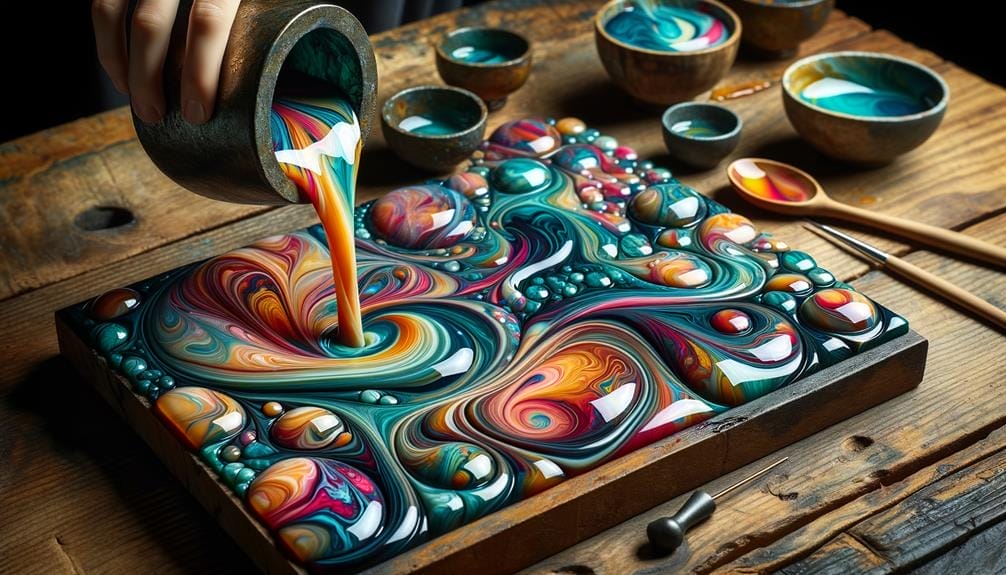Are you tired of the limitations that traditional molds impose on your resin projects? Look no further than epoxy resin molds and forms.
These remarkable tools will revolutionize your crafting experience with their incredible versatility and ease of use.
But that's not all – they offer so much more than meets the eye. From choosing the perfect mold for your project to exploring alternative materials, this discussion will uncover all the secrets to taking your resin crafts to the next level.
So, get ready to unleash your creativity and discover the endless possibilities that epoxy resin molds and forms have in store for you.
Key Takeaways
- Epoxy resin molds and forms are available in various types, including rectangle NO SEAL molds, one-piece resin molds (Black Edition), small reusable silicone molds, mold release for HDPE molds, and reusable charcuterie board silicone molds.
- Using epoxy resin forms offers several benefits, such as high durability, versatility in design, suitability for various projects, professional and consistent results, and cost-efficiency as an alternative to traditional form materials.
- No Seal HDPE forms are highly durable, resistant to warping, cracking, and moisture damage, and can withstand the pressure and weight of resin pours. They are suitable for flat and curved surfaces, making them ideal for both beginners and experienced artists. These forms also offer compatibility with different types of resin, allowing for intricate details and textures.
- When choosing the right mold for a project, factors to consider include the mold material that suits your needs, the size and shape that accommodates your project, the application of a release agent, and the durability of the materials for long-term use. Additionally, considering the compatibility with different types of resin, the desired depth of resin pour, and the cost-effectiveness and reduced material waste are important considerations.
Types of Epoxy Resin Molds
There are several types of epoxy resin molds available for various projects. These include rectangle NO SEAL molds, one-piece resin molds (Black Edition), small reusable silicone molds, mold release for HDPE molds, and reusable charcuterie board silicone molds.
Let's start with the small reusable silicone molds. These molds, offered by Jeff Mack Supply, are perfect for makers looking to create smooth finished pieces. The shiny interior ensures a polished look to your epoxy creations. What's more, these molds are available at affordable prices, making them accessible to a wide range of hobbyists and professionals alike.
Moving on, we've the rectangle NO SEAL molds. These molds are designed to be reusable and come in various sizes and price ranges. They're suitable for epoxy and wood projects and can be a great addition to your crafting arsenal. With their versatility, you can create a wide range of shapes and designs.
Another option is the one-piece resin molds, also known as the Black Edition molds by Jeff Mack Supply. These Empire Molds are highly recommended for both hobbyists and professionals. They come at different price points, allowing you to choose the one that fits your budget. These molds are designed to meet the needs of individuals with different skill levels, ensuring a seamless resin casting experience.
To ensure the longevity of your molds, Jeff Mack Supply offers mold release specifically designed for HDPE molds and Empire Molds. Using mold release will help prolong the lifespan of your molds, saving you money in the long run.
Lastly, for those interested in creating charcuterie boards, the reusable charcuterie board silicone molds are the perfect choice. These molds, also available at Jeff Mack Supply, are thicker than average silicone molds, ensuring durability and longevity. With these molds, you can create stunning charcuterie boards that will impress your guests.
Benefits of Using Epoxy Resin Forms
Using epoxy resin forms offers several benefits that make them a practical choice for your projects.
Firstly, these forms are highly durable, ensuring they can withstand the pressure and weight of the resin without warping or breaking.
Additionally, epoxy resin forms are incredibly versatile in design, allowing you to create intricate and unique shapes for your molds. This versatility opens up endless possibilities for your projects, whether you're making coasters or small dining tables.
Durability of Epoxy Forms
No Seal HDPE forms offer exceptional durability, ensuring long-lasting and reusable performance for multiple resin pouring projects. These forms are highly resistant to warping, cracking, and moisture damage, making them a reliable choice for any resin artist.
With the ability to withstand the pressure and weight of resin pours, these forms guarantee consistent and professional results with each use. Their versatility allows for various design possibilities and shapes, suitable for both flat and curved surfaces, enabling the production of unique and customized resin pieces.
The ease of use with No Seal HDPE forms eliminates the need for additional sealing or priming before pouring resin, making them ideal for both beginners and experienced resin artists.
Furthermore, these forms provide a cost-efficient alternative to traditional form materials, minimizing material waste during the pouring process and offering a long-term investment for resin pouring projects.
Versatility in Design
With its exceptional durability and ability to withstand the pressure and weight of resin pours, No Seal HDPE forms offer resin artists a versatile solution for creating unique and customized pieces. These forms are designed to be compatible with different types of resin, such as epoxy or polyester, allowing for diverse design possibilities and shapes. Whether you're creating coasters or small dining tables, these forms offer flexibility in creative applications. The No Seal HDPE forms enable the production of unique and customized pieces, providing freedom for intricate details and textures in resin creations. Unlike silicone molds, there is no need for additional sealing or priming before pouring resin, providing a hassle-free and user-friendly experience. Additionally, these forms offer a cost-efficient alternative to traditional form materials, reducing the need for frequent replacements and minimizing material waste during the pouring process.
| Benefits of No Seal HDPE Forms | ||
|---|---|---|
| Versatile design | Compatible with different types of resin | Freedom for intricate details and textures |
| Hassle-free experience | Cost-efficient alternative to traditional form materials |
Choosing the Right Mold for Your Project
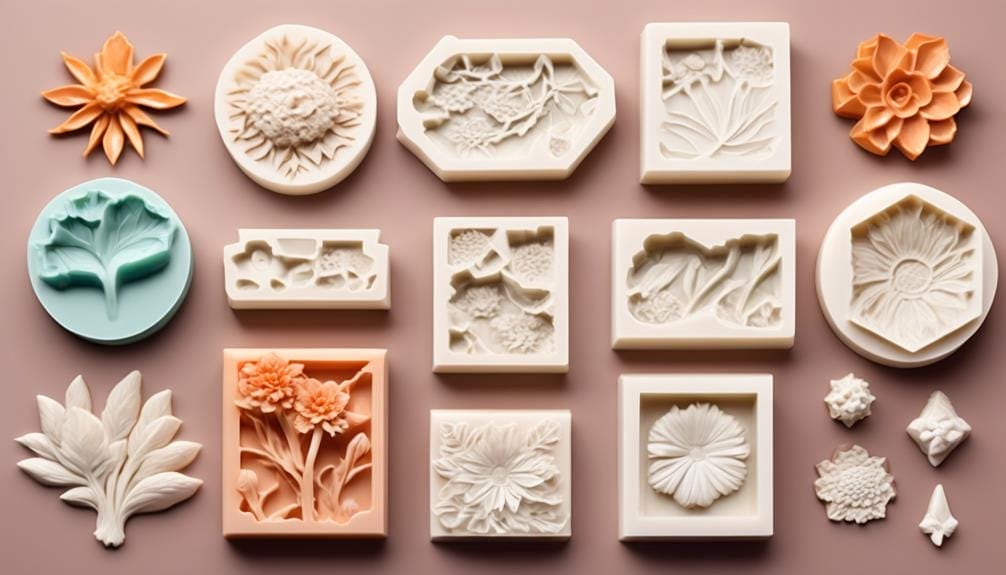
When choosing the right mold for your epoxy resin project, there are several key points to consider.
First, you need to decide on the mold material that will best suit your needs.
Additionally, consider the size and shape of your project to ensure that the mold can accommodate it.
Lastly, don't forget to factor in the application of a release agent to facilitate easy removal of the resin from the mold.
Mold Material Options
Different mold material options, including HDPE, silicone, and acrylic, are available to cater to the specific needs of your project.
When it comes to silicone molds, they offer a shiny interior that results in smooth finished pieces. This makes them ideal for creating intricate designs and textures in your epoxy resin projects.
Additionally, HDPE molds are a popular choice as they don't require the use of mold release, saving you time and effort during resin pouring and demolding.
On the other hand, acrylic router templates are perfect for adding decorative inlays to woodworking projects and achieving precise epoxy pours.
Choosing the right mold material is crucial to ensure ease of use, durability, and compatibility with different types of resin.
Size and Shape Considerations
Consider the dimensions and shapes of your project to ensure the mold you choose aligns perfectly with your creative vision. When selecting a mold size, it's crucial to factor in the desired depth of resin pour, keeping in mind the requirements of your project.
Additionally, assess the mold's versatility to accommodate different types of resin, whether for flat or curved surfaces, and intricate details.
Look for molds made of durable materials, such as high-density polyethylene (HDPE), to ensure long-term use and resistance to warping or cracking.
Cost-effectiveness is another important consideration, as it includes the potential for long-term investment and reduced material waste during the pouring process.
Release Agent Application
To ensure optimal results for your epoxy resin project, it's essential to select the appropriate mold release agent for your chosen mold. Here are four key considerations when applying a release agent:
- Choose A80 Silicone Lubricant for Empire Molds: For prolonging the lifespan of your molds, it's recommended to use A80 Silicone Lubricant as a release agent for Empire Molds. This will aid in the demolding process and make it easier to remove the cured epoxy.
- Consider mold release for HDPE forms: HDPE forms can benefit from using a mold release agent to facilitate the demolding process. Applying a release agent will ensure the seamless removal of the cured epoxy.
- No Seal HDPE forms for quick setup: When using No Seal HDPE forms, there's no need for additional sealing or priming before pouring resin. This leads to a quick setup and demolding process, saving you time and effort.
- Cost-efficient alternative with No Seal HDPE forms: Opting for No Seal HDPE forms not only eliminates the need for additional mold release agents but also provides a cost-efficient alternative to traditional form materials. This can save you money on frequent replacements and additional sealants.
Tips for Preparing Your Mold for Resin Pouring
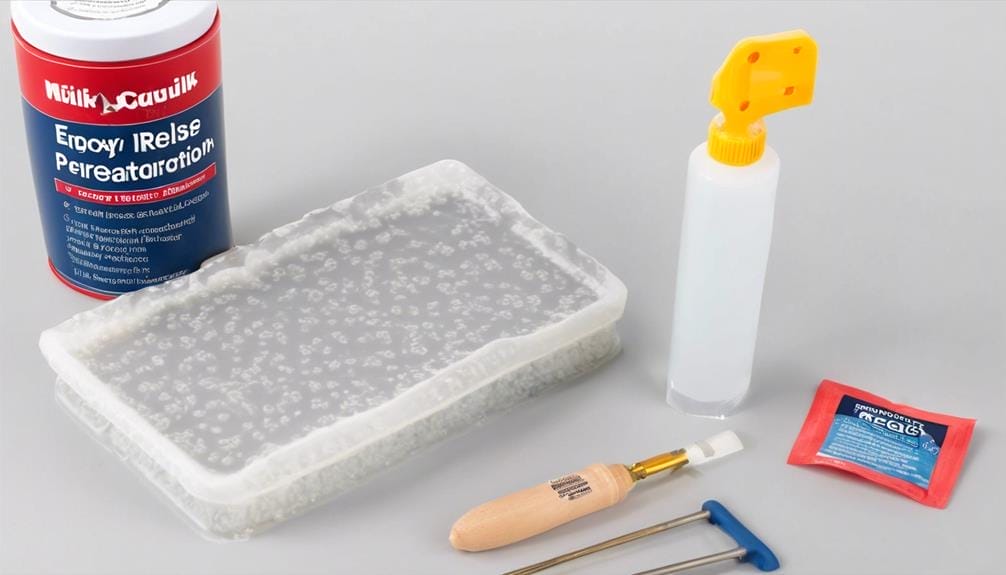
For optimal resin pouring results, ensure your silicone mold is placed on a flat surface to promote even distribution of the epoxy resin. This is crucial as it allows the resin to flow smoothly and evenly, preventing any uneven thickness or pooling. Avoid placing the mold on elevated platforms or uneven surfaces, as this can cause leaks during the resin pouring process, leading to a messy and unsatisfactory outcome.
To make the resin removal process easier and prolong the lifespan of your mold, consider using a mold release agent. This helps prevent the epoxy resin from sticking to the mold, allowing for easy removal once the resin has cured. It's recommended to follow the manufacturer's instructions when applying the mold release agent to ensure proper usage.
Layout templates can be incredibly helpful in achieving precise resin pouring. These templates assist in accurately positioning and trimming your silicone mold, ensuring that the resin is poured exactly where you want it. By using layout templates, you can achieve clean lines and precise designs, resulting in a professional-looking finished product.
If you have any questions or need additional support regarding resin pouring, check out the frequently asked questions (FAQs) section. This resource provides answers to common queries, offering guidance and troubleshooting tips to help you achieve resin pouring success.
Techniques for Creating Unique Designs With Epoxy Resin
Are you looking to create unique designs with epoxy resin? Here are some techniques you can use to achieve stunning and one-of-a-kind creations with epoxy resin molds and forms:
- Layering: Experiment with layering different colors of epoxy resin to create marbled effects. By carefully pouring and manipulating the resin, you can achieve beautiful swirls and patterns.
- Metallic Powders and Glitter: Add a touch of shimmer and sparkle to your resin designs by incorporating metallic powders or glitter. Mix them into the resin before pouring to create a dazzling finish.
- Intricate Mold Details: Choose molds with intricate details to create textured and visually appealing resin pieces. The unique shapes and patterns provided by these molds will add depth and interest to your designs.
- Object Embedding: Personalize your resin pieces by embedding objects such as flowers or beads within the resin. This technique allows you to create resin pieces that showcase your own style and creativity.
How to Properly Demold Your Epoxy Resin Creations

When demolding your epoxy resin creations, it's important to take the proper steps to ensure a successful and damage-free process. Gently tapping the mold with a rubber mallet can help release the epoxy creation without causing any damage. This gentle tapping motion helps to loosen the epoxy from the mold and allows for easier removal.
Another technique to facilitate easy removal of the cured resin from the mold is to use a mold release agent. Applying this agent before pouring the epoxy can prevent the resin from sticking to the mold, making demolding much simpler.
To prevent any potential leaks during the pouring and curing process, it's crucial to place the mold on a flat surface. This ensures that the epoxy is evenly distributed and prevents any unwanted spillage or uneven curing.
For precise epoxy pouring and trimming processes, using layout templates can be beneficial. These templates guide you in achieving accurate designs and shapes, resulting in professional-looking resin creations.
If you're using HDPE molds, you'll be pleased to know that no additional sealing or priming is necessary before pouring the resin. This makes the demolding process quick and easy. HDPE molds have a natural release property, allowing the epoxy creation to be effortlessly removed from the mold without the need for extra steps.
Cleaning and Maintaining Your Epoxy Resin Molds
To properly maintain your epoxy resin molds, it's essential to regularly clean them using warm soapy water and a soft sponge to remove any residue or build-up. Here are some important steps to follow when cleaning and maintaining your epoxy resin molds:
- Regular Inspection: Take the time to inspect your molds for any cracks, chips, or imperfections that could affect the quality of the resin castings. It's crucial to identify and address any issues before using the molds again.
- Proper Storage: Store your molds in a cool, dry place away from direct sunlight. This will help prevent warping or degradation of the mold material, ensuring the longevity of your molds.
- Maintaining Silicone Molds: If you're using silicone molds, it's important to maintain their shine and smoothness. After cleaning, consider using a silicone mold conditioner or talcum powder to keep the molds in top condition.
- Mold Release Agent: To prolong the lifespan of your molds and ensure easy release of the cured resin castings, use a mold release agent. This will help prevent the resin from sticking to the mold, making demolding much easier.
Common Mistakes to Avoid When Working With Epoxy Resin Forms
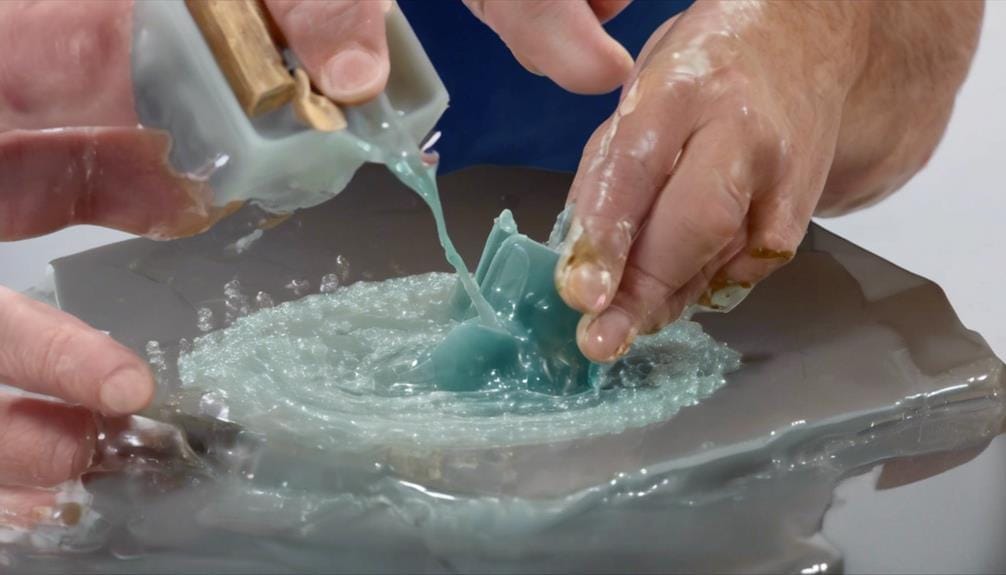
One common mistake to avoid when working with epoxy resin forms is failing to properly level the surface before pouring the resin. Uneven surfaces can cause the resin to cure unevenly, resulting in an unsightly and unprofessional finish. To ensure an even surface, use a leveling tool or a straight edge to check for any high or low spots. If necessary, sand down any imperfections before pouring the resin.
Another mistake to avoid is using too much force when demolding the cured resin. Epoxy resin forms are designed to be flexible, but excessive force can cause the mold to tear or the resin to crack. To demold the resin, gently flex the mold or use a release agent to make the process easier.
Thoroughly mixing the resin components is crucial to prevent curing issues and soft spots in the final product. Incomplete mixing can result in uncured resin or areas that remain sticky and tacky. To ensure proper mixing, follow the manufacturer's instructions and use a scraping motion to combine the components thoroughly.
Protecting the mold from direct sunlight and extreme temperatures is also important to maintain its durability and lifespan. Exposure to sunlight can cause the mold to warp or yellow over time, while extreme temperatures can affect the resin's curing process. Store the mold in a cool, dry place away from direct sunlight to ensure its longevity.
Lastly, cleaning the mold thoroughly after each use is essential to prevent resin buildup and ensure a smooth surface for future projects. Residue and debris left behind can affect the quality of the next cast and make it difficult to remove the cured resin from the mold. Use warm soapy water and a soft brush to clean the mold, ensuring all residue is removed before storing it for future use.
Enhancing Your Resin Crafts With Mold Accessories
Enhancing your resin crafts with mold accessories can greatly improve the quality and precision of your creations.
Mold enhancements such as mold release for HDPE molds can prolong their lifespan and ensure smooth demolding.
Additionally, layout templates provide precise pouring guides for Empire Molds, Silicone Molds, and No Seal Molds, resulting in accurate and consistent epoxy pours.
With a wide range of epoxy/resin mold accessories available, you can find the perfect tools to enhance the usability and functionality of your HDPE epoxy forms.
Mold Enhancements
You can enhance your resin crafts with a range of mold accessories. These include mold release for HDPE molds, layout templates for precise epoxy pouring, acrylic router templates for decorative cross inlays, and no seal HDPE forms for consistent and professional results.
- Mold Release (for HDPE Molds): Prolongs the lifespan of the molds and is recommended for Empire Molds and HDPE molds.
- Layout Templates: Laser-cut acrylic templates for precise epoxy pouring, compatible with Empire Molds, Silicone Molds, and No Seal Molds.
- Acrylic Router Templates for Cross Inlays: Designed for creating decorative cross inlays to woodworking projects, available in 3 different sizes.
- No Seal HDPE Forms: Made from high-density polyethylene, resistant to warping, cracking, and moisture damage, ensuring consistent and professional results.
Creative Resin Accessories
To further enhance your resin crafts, consider incorporating a variety of mold accessories that can elevate the quality and precision of your epoxy creations. Reusable forms, such as Rectangle NO SEAL Resin Molds and One Piece Resin Molds (Black Edition) by Jeff Mack Supply, are available in different price ranges.
For Empire Molds, it's recommended to use mold release products like A80 Silicone Lubricant to prolong the lifespan of HDPE molds.
Layout Templates, compatible with Empire Molds, Silicone Molds, and No Seal Molds, provide precise epoxy pouring assistance.
The One Piece Resin Molds (Guaranteed for Life) by Jeff Mack Supply come with a lifetime guarantee against cracks and leaks, and are recommended for use with Ecopoxy Flow.
Epoxy/Resin Mold Accessories, rated 4.9 / 5.0, enhance the usability of HDPE Epoxy forms and are available at various price points.
Exploring Alternative Materials for Resin Molds and Forms
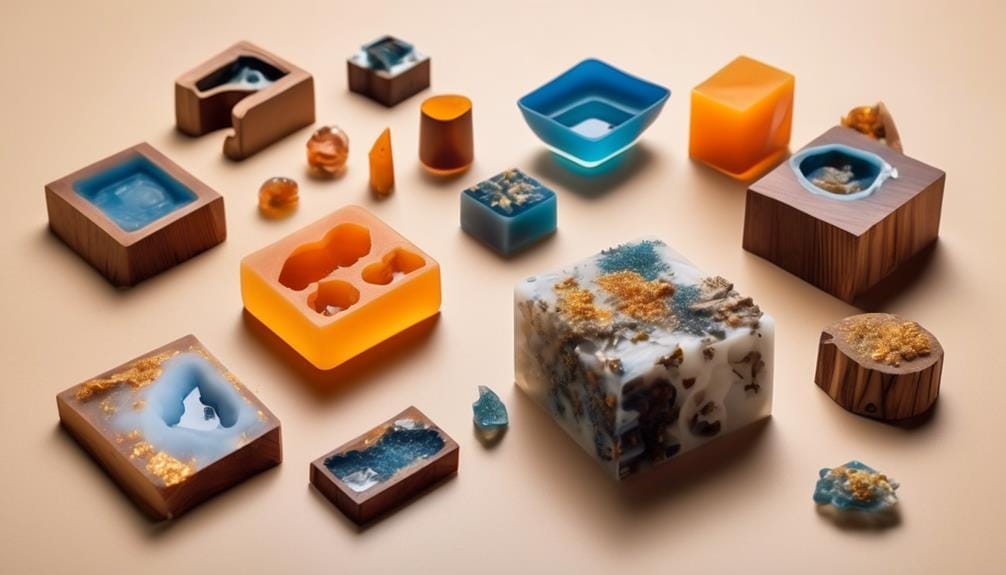
One possible alternative material for resin molds and forms is high-density polyethylene (HDPE), which offers durability, resistance to warping and moisture damage, and versatility in use with various resin types and design possibilities. HDPE provides a reliable option for creating molds and forms that can withstand the demands of epoxy and wood projects.
Here are four reasons why HDPE is a promising alternative material:
- Durability: HDPE is known for its strength and toughness, making it highly resistant to impact and wear. This ensures that the molds and forms made from HDPE will have a long lifespan, even with frequent use.
- Resistance to warping: Unlike other materials like wood, HDPE isn't prone to warping when exposed to moisture or changes in temperature. This stability ensures that the molds and forms maintain their shape and dimensions throughout the resin curing process.
- Moisture damage resistance: HDPE is inherently waterproof, making it an excellent choice for creating molds and forms that come into contact with wet or damp materials. This resistance to moisture damage ensures the longevity and integrity of the molds.
- Versatility: HDPE can be easily shaped and molded to accommodate various resin types and design requirements. Its flexibility allows for the creation of intricate and complex molds and forms, making it suitable for a wide range of epoxy and wood projects.
Advanced Techniques for Experienced Resin Artists
Advanced resin artists can enhance their creations by incorporating innovative techniques that add depth, dimension, and unique visual effects to their resin pieces.
One technique to achieve this is through multi-layer resin casting. By pouring resin in multiple layers, you can create a sense of depth and dimension in your artwork. Experimenting with the addition of metallic powders, glitter, or ink can also yield stunning effects and color combinations. These additives can be mixed into the resin before pouring or sprinkled on top for a more dramatic effect.
To achieve a flawless finish on your resin pieces, it's important to properly seal the epoxy or resin forms. This can be done by carefully inspecting the molds for any imperfections or leaks before pouring the resin. Additionally, using a sealant or mold release spray can help prevent the resin from sticking to the mold, making it easier to remove once it has cured.
To ensure a glass-like finish and remove any bubbles that may have formed during the pouring process, advanced resin artists can use heat guns or torches. By gently heating the surface of the resin, the bubbles will rise to the surface and pop, leaving behind a smooth and glossy finish.
Another technique to consider is embedding objects into your resin creations. This can include items such as flowers, shells, or small trinkets. By carefully placing these objects into the resin, you can add a personalized touch to your artwork and create a unique visual effect.
For those looking to take their resin artistry to the next level, advanced techniques such as resin marbling, geode-style designs, or resin petri art can be explored. These techniques involve manipulating the resin to create intricate patterns and designs, resulting in visually stunning and one-of-a-kind pieces.
Frequently Asked Questions
What Is the Best Mould for Epoxy Resin?
When choosing the best mold for epoxy resin, consider factors like size, shape, and material. A mold that is compatible with epoxy resin will ensure successful casting and a smooth finish for your project.
How Do You Keep Epoxy From Sticking to Mold?
To keep epoxy from sticking to your mold, try alternative methods like using mold release agents or ensuring a flat surface for pouring. These techniques can prevent leaks and make it easier to remove the epoxy.
What Does Epoxy Not Stick To?
Epoxy does not stick to certain surfaces, like silicone, HDPE, polished materials, and nonporous materials. This property allows for innovative applications, such as easy demolding, effortless release and reuse, and smooth removal of cured resin.
Can I Make My Own Epoxy Mold?
Yes, you can make your own epoxy mold. It is a DIY project that allows you to create custom molds for your epoxy resin projects.
Conclusion
In conclusion, epoxy resin molds and forms offer a seamless and cost-effective solution for creating stunning epoxy and wood projects. These versatile tools eliminate the need for additional sealing or priming, making them a convenient choice for both hobbyists and professionals.
By exploring various techniques and avoiding common mistakes, resin artists can enhance their crafts and create unique designs. With the right mold accessories and a willingness to explore alternative materials, the possibilities for resin crafting are truly limitless.

